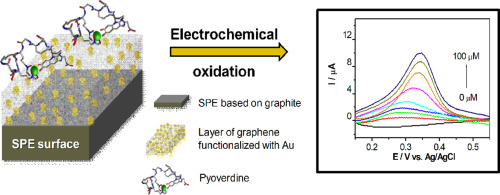Bioelectrochemistry ( IF 5 ) Pub Date : 2017-12-05 , DOI: 10.1016/j.bioelechem.2017.11.014 Islem Gandouzi , Mihaela Tertis , Andreea Cernat , Amina Bakhrouf , Maria Coros , Stela Pruneanu , Cecilia Cristea

|
The design and development of an electrochemical sensor for the sensitive and selective determination of pyoverdine, a virulence factor secreted by Pseudomonas aeruginosa, bacteria involved in nosocomial infections is presented in this work. The presence of pyoverdine in water and body fluids samples can be directly linked to the presence of the Pseudomonas bacteria, thus being a nontoxic and low cost marker for the detection of water pollution as well as for the biological contamination of other media. The sensor was elaborated using layer-by-layer technique for the deposition of a graphene‑gold nanoparticles composite film on the graphite-based screen printed electrode, from aqueous suspension. Under optimal conditions, the electrochemical signal corresponding to the pyoverdine oxidation process was proportional to its concentration, showing a wide linear range from 1 to 100 μmol L− 1 and a detection limit of 0.33 μmol L− 1. This sensor discriminate with satisfactory recoveries the target analyte in different real matrices and also exhibited low response to other interfering species, proving that this technique is promising for medical and environmental applications. In addition, the proposed nanocomposite platform presented good reproducibility, high and long term stability, the sensitivity for pyoverdine remain unchanged after being stored at 4 °C for four weeks.
中文翻译:

基于电化学生成的金纳米粒子官能化的石墨烯,通过电化学传感器灵敏地检测出pyoverdine
在这项工作中介绍了用于灵敏和选择性测定铜绿假单胞菌分泌的毒力因子-吡over定的电化学传感器的设计和开发。水和体液样品中的吡over定的存在可以与假单胞菌的存在直接相关细菌,因此是检测水污染以及其他介质的生物污染的无毒且低成本的标记。使用逐层技术对传感器进行了精加工,以从水性悬浮液在石墨基丝网印刷电极上沉积石墨烯-金纳米颗粒复合膜。在最佳条件下,对应于pyoverdine氧化过程的电化学信号是正比于它的浓度,表示1〜100微摩尔升的线性范围宽- 1和0.33微摩尔升的检测限- 1。该传感器能够以令人满意的回收率区分出不同真实基质中的目标分析物,并且对其他干扰物质的响应也很低,证明该技术在医学和环境应用中很有希望。此外,拟议的纳米复合材料平台具有良好的重现性,长期和长期稳定性,在4°C下储存4周后,对嘧啶的敏感性保持不变。



























 京公网安备 11010802027423号
京公网安备 11010802027423号